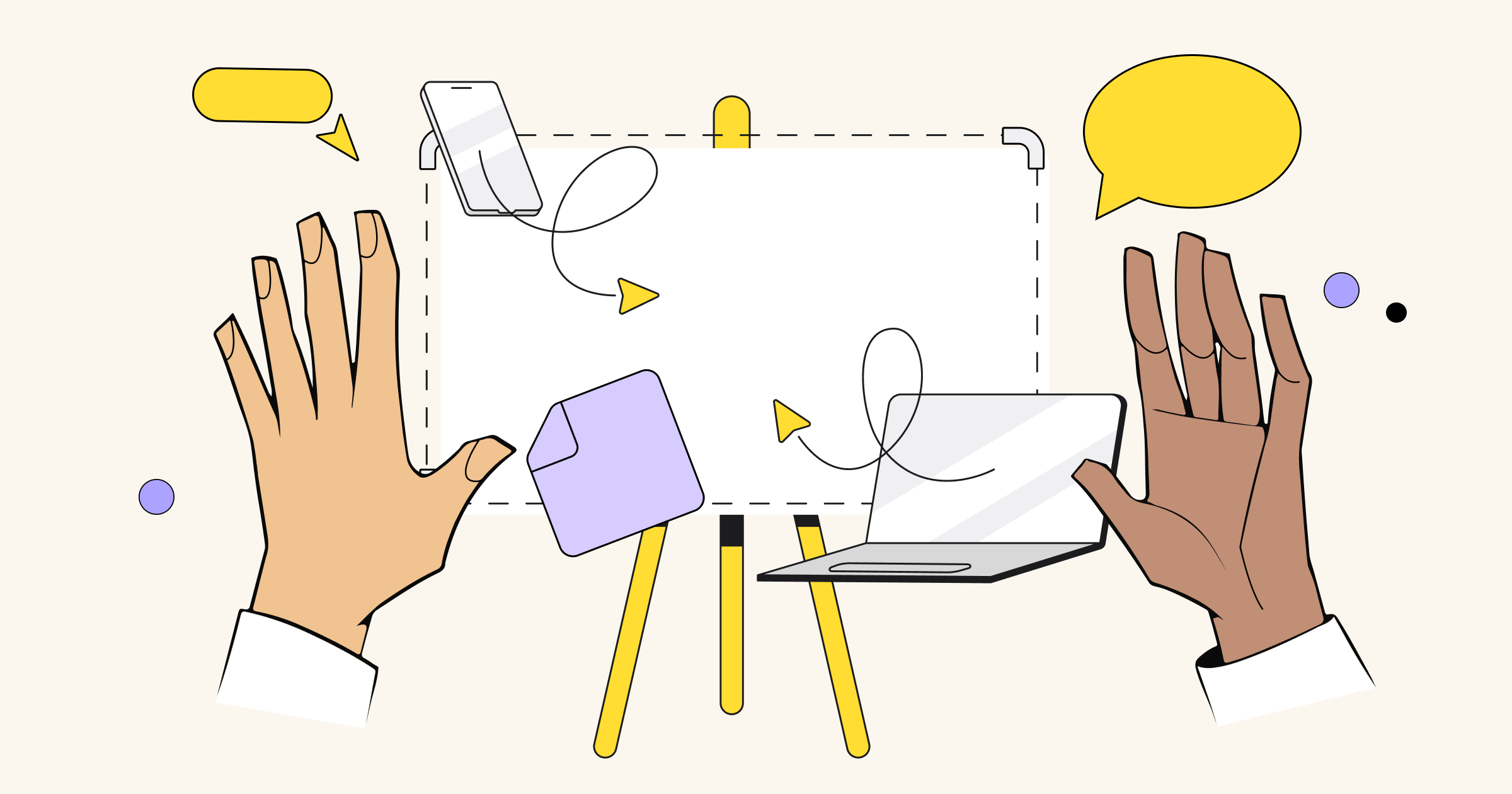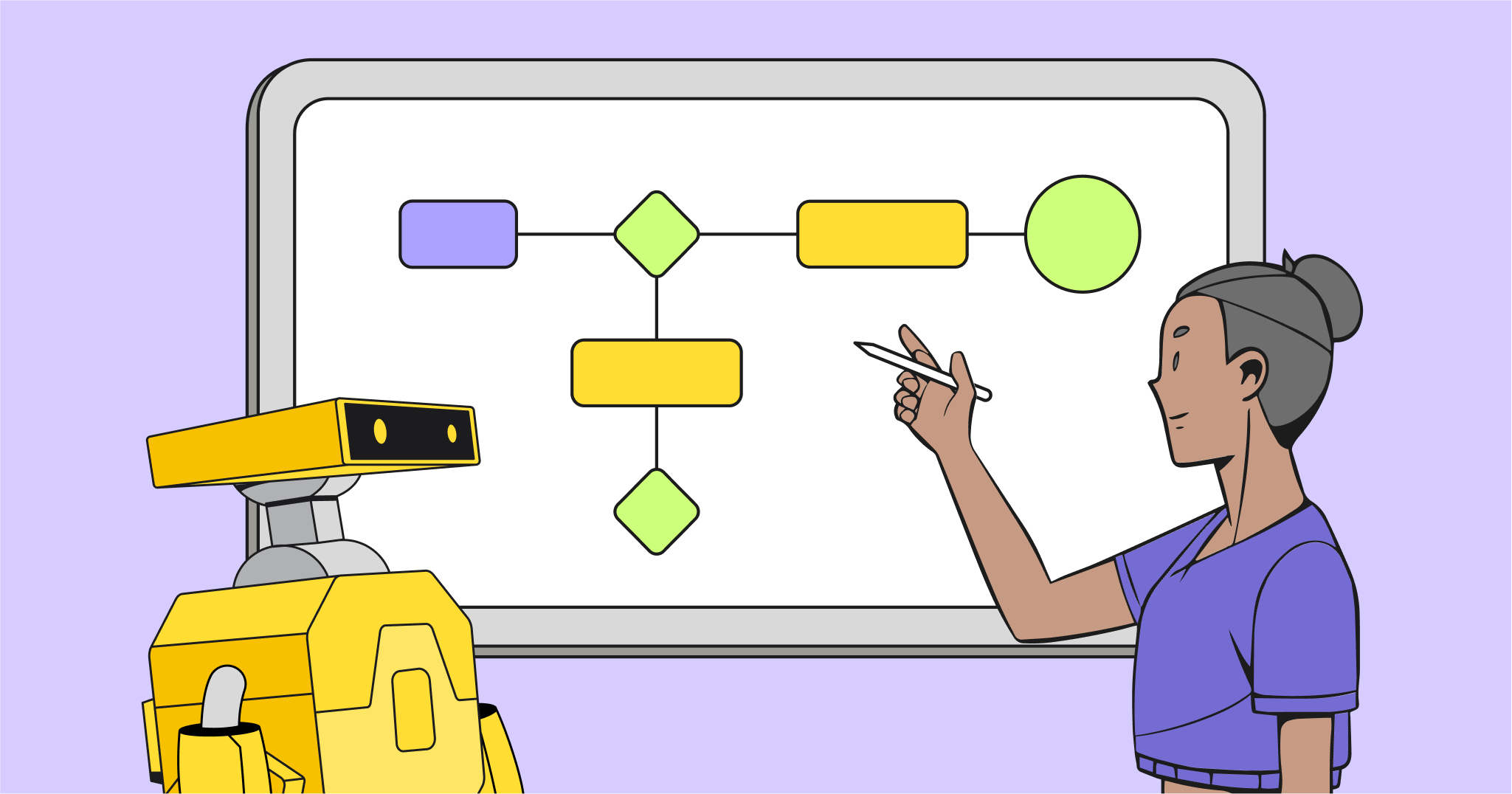Brainstorms are a great way to tap into the collective brilliance of your team and explore their best ideas. But, making that happen requires that you plan for a focused, organized, and inclusive conversation. If you don’t? You’ll miss out on some of the best contributions and nuggets of wisdom.
Not sure how to make sure your brainstorms are fruitful rather than frustrating? Here are strategies you can use — before, during, and after your brainstorming session — to make sure everybody feels empowered to voice their big ideas.
Before your brainstorming session
Inclusive brainstorming begins well before your meeting actually kicks off. As you prepare for that conversation, here are a few steps to take to set everybody up for success.
1. Share an agenda and expectations
Is there anything worse than seeing a generic “brainstorm” dropped on your calendar? You’re left in the dark about whether you’re going to discuss ways to reduce customer churn or you’re going to debate the best pizza toppings. That meeting could mean anything.
People shouldn’t walk into a brainstorm session feeling completely lost. Ahead of the meeting (at least 24 hours – but more time is always helpful), share an agenda that details who’s attending the meeting and what you’ll discuss. At that same time, you can ask if participants feel there’s anything that should be added to the agenda.
You should also quickly outline some expectations for how much people will be expected to participate or contribute as well as if there are any materials or resources they need to come prepared with.
2. Ask questions and provide resources
Some people don’t perform well under pressure, so it’s helpful to empower them with information ahead of your brainstorm.
That doesn’t only involve sending a quick agenda or meeting outline. You should also send any supplemental resources – data, reports, files, or other assets – ahead of the conversation so everybody has adequate time to review those.
Depending on what you’re brainstorming, you might also want to send a few questions or prompts that people can noodle on independently. It can be surprisingly effective. One Yale study found that people working alone actually came up with twice as many answers to puzzles as people who worked in groups.
Taking these steps means that everybody can come to your brainstorming sessions with some thoughtful ideas and input in their back pockets – rather than needing to think on their feet.
3. Foster psychological safety
Okay, so this one is going to require a little more elbow grease than coming up with a few questions or hashing out an agenda. It requires constant effort and, in some cases, a cultural shift. However, it’s a crucial step for ensuring inclusivity not just in your brainstorms, but on your team as a whole.
In your brainstorming sessions, most people will resist chiming in because of something called evaluation apprehension – the fear that they’re going to get a negative reaction from the people they’re sharing with.
That’s why psychological safety is so important. It means that people feel comfortable speaking up, taking risks, or even making mistakes without fear of judgment or reprimands. That sense of security is obviously important for productive and fruitful brainstorming sessions.
There’s no easy way to foster psychological safety on your team, but a few steps you can take include:
- Talking candidly about your own successes and failures
- Hosting retrospectives to emphasize that mistakes are the beginning of the road, not the end of it
- Regularly, soliciting feedback, as research shows that employees are more likely to speak up when they believe their leader actively seeks their opinions
- Providing encouragement, support, and resources for employees to pursue big ideas
- Implementing feedback, as 45% of employees don’t believe their feedback leads to any meaningful changes
Any combination of those strategies will make your team more inclusive, vulnerable, and supportive – and those feelings will carry through to all of your brainstorming sessions.
During your brainstorming session
Laying the groundwork is important, but it doesn’t mean that your brainstorming session will run flawlessly from there. Here are some more tips to implement during your actual meeting to ensure that everybody has equal opportunity to jump in with their biggest and boldest ideas.
1. Provide a spot for people to jot down ideas
Wondering why it’s challenging to get people to speak up in meetings? Well, to state it simply, we’re quite literally programmed to censor ourselves at work.
For that reason, not everybody feels comfortable with the rapid fire or free-for-all vibe of most brainstorming sessions. Incorporating some options where people can share their ideas in writing – rather than by jumping into a lively conversation – can help.
Encourage participants to use the chat function during a virtual brainstorm. Or, set up a Miro board for people to jot ideas and participate in brainwriting. Research shows it’s effective, plus it’s way less intimidating for people who aren’t as confident cutting into back-and-forth conversations.
2. Come prepared with a collaborative exercise
Tack the word “mandatory” on to anything and it’s bound to inspire some groans and eyerolls. However, coming up with a lighthearted and low-pressure brainstorming exercise that requires everybody to be actively involved is a great way to give people equal opportunity to contribute.
You could try a brainstorming technique like:
- Round Robin: One participant shares an idea. Then, go around the group and challenge each person to share an idea that builds off of the previous one.
- Step Ladder: Ask two group members to discuss the topic. Then add a third member. Then a fourth. Then a fifth. Do that until everybody has contributed.
- Crazy Eights: Give each participant a template that has eight boxes and set a timer for eight minutes. Everybody has that time to sketch eight quick ideas. Once time is up, go around and share.
All of those provide some structure so that even your most introverted or reserved team members have dedicated time to offer their suggestions.
3. Rotate roles
People tend to fall into comfortable positions for meetings and brainstorming sessions. The same person always wants to be the notetaker. You’re always the facilitator.
What if you switched things up? Ask somebody else to lead the brainstorming session. Or ask one of your most extroverted and outspoken team members to take the notes.
It gets people out of their ruts and default roles and can breathe some new life – not to mention far more inclusivity – into your brainstorming sessions. In fact, it’s a tip that Google uses and recommends.
4. Manage interruptions
Here’s the thing: Interruptions are going to happen. Brainstorming sessions often involve piggybacking off of other people’s ideas. Team members get excited to jump in and add on to somebody else’s contribution.
While interruptions are a natural part of the process, you can’t allow them to throw your whole meeting off track. Too many (especially repeated ones) make people feel like they need to fight to be heard. If that’s the case, some people will choose to keep their lips zipped rather than throw elbows for their chance to speak.
That’s why you need to openly address interruptions during your brainstorm. This isn’t about inspiring shame, slapping someone on the hand, or even having some big, formal reprimand or conversation. Even the simplest phrases and corrections can do the trick. Here are a few to try:
- “I’m excited to hear you build on that, but let’s give [Name] a chance to finish that thought.”
- “I appreciate that you want to keep this rolling, but I want to make sure [Name] has finished sharing first.”
- “We can come back to this in a minute. But first, [Name], is there anything else you wanted to share?”
After your brainstorming session
Your brainstorming session has ended, but your work isn’t quite done. Here are a few more steps to take to ensure that everybody feels that conversation was a good use of their time and energy.
1. Assign action items
We’ve all attended a brainstorming session that generated a ton of ideas – only for them to collect dust before eventually disappearing. When 71% of senior managers say meetings are unproductive and inefficient, your brainstorms can’t only be about coming up with ideas. You also need to figure out how you’ll execute the ones that are deemed worth pursuing.
That starts with making sure everybody knows what their next steps are. Come up with action items and owners and then list those in your meeting summary or on your Miro board.
People can walk out of your brainstorming session with clear responsibilities – rather than wondering if all of those ideas are destined for disappearance.
2. Pursue ideas and suggestions
Did somebody mention something in your session that you thought was interesting, but you either didn’t have time to ask them to expand or figured they wouldn’t be comfortable in the hot seat?After the meeting, check in with them. Send a simple instant message or have a friendly one-on-one chat to ask a few follow-up questions.
It gives you more information about an insightful idea while also showing employees that you truly do value and consider their contributions – making them that much more likely to speak up next time.
3. Collect feedback
Maybe the icebreaker exercise you did was cringe-worthy. Or maybe participants would like more time to brainstorm independently before coming together.
Regardless of the specifics, people will have a lot of opinions on your brainstorming sessions. That’s valuable insight you can use to improve these types of meetings moving forward.
But not everybody will feel comfortable sharing their two cents about your recent session without being asked. After a brainstorming session, send out a quick survey (it can be anonymous or not – that’s up to you) to understand how people felt about the meeting and what they’d like to change in the future.
When you have that feedback? Make sure to actually implement it to make your future brainstorming sessions even more productive and inclusive.
Better brainstorming starts with inclusivity
For some people, a brainstorming session is a welcomed opportunity for them to step into the spotlight and share their brightest ideas and most meaningful wisdom.
For others? It’s an anxiety-inducing requirement where they need to think on their feet and face judgment from the people they work with.
Fortunately, there’s a way you can find some middle ground here. Implement the above strategies before, during, and after your brainstorming sessions and you’ll transform them into creative, collaborative, and inclusive conversations where everybody feels heard, supported, and valued.
Ready to help your team share and pursue their best ideas? Get started with Miro for free today.






